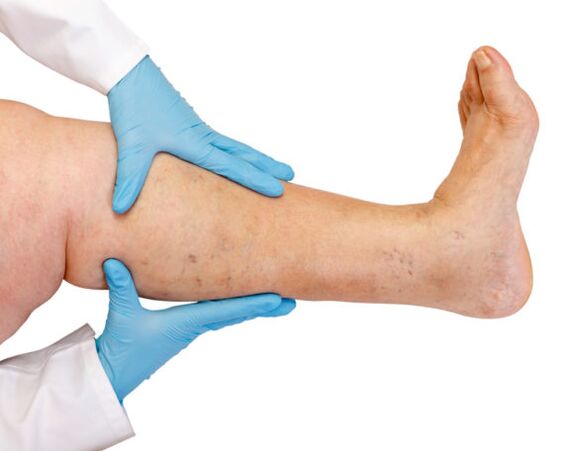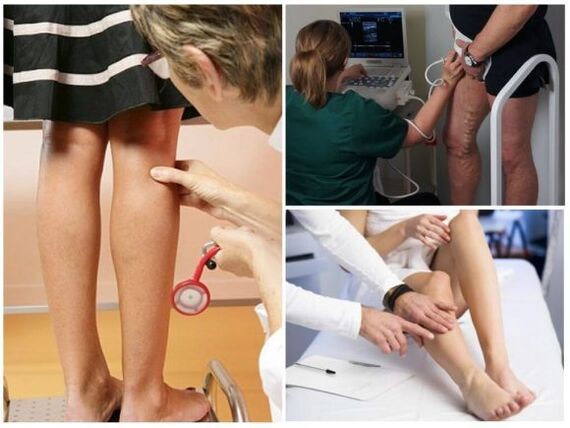Once you read the article, then you are facing a problem such as varicose veins.Internal varicose veins are a common, familiar disease for both men and women.The article below discusses the manifestations of the disease, diagnostic methods, and information on how to cure internal varicose veins on the legs.

Symptoms
In a healthy condition, the veins on the legs are virtually unable to hide under the skin and function normally, without any problems with the person.But with diseases such as internal varicose veins on the legs, you can protect against enlarged venous mesh nodes, and in advanced cases with trophic ulcers.
Varicose is not only a cosmetic defect but also a very dangerous disease that should be identified at an early stage and consult a phlebologist.Varicosis of the veins in the limbs is due to blood stagnation, impaired function of venous valves, which contributes to the blood in the heart and does not decrease.
Symptoms of deep veins that should pay attention to:
- Pigmentation, dryness, burning on the lower extremities;
- Swelling and gravity at the end or end of the day;
- Pain in the lower extremities;
- Extended venous network appearance on the legs.

At the beginning of the disease, it is easy to win, but advanced cases are full of complications.
Internal varicose veins on the legs can cause trophic ulcers that have long been bleeding and healing, and the most dangerous consequence of the pathology is the formation of blood clotting.
Thrombus can at any time a distance and important vessels that can lead to death.Therefore, there is no need to neglect the disease at first glance.
Varicose veins on the legs have a genetic predisposition.If the closest relatives are in such a situation, be careful and take preventive measures.
Causes
The reasons for the visiting vascular network may be:
- Excessive load on the legs;
- Obesity;
- Hormone therapy;
- Pregnancy or menopause;
- Clumsy shoes;
- Long presence on legs (standing or sitting at work and lifestyle).
The internal expansion of the lower extremity veins is clearly depicted in the photo.
Of course
The stages of disease development are as follows:
- Stage First: A person practically does not pay attention to his or her condition, sometimes hesitating after a long walk or serious physical effort.
- Stage 2: By this time the patient has already begun swelling, pain is intense, varicosexosis appears, night cramps may occur.
- Stage 3: The condition exacerbates, swelling of the legs is improved, pigmentation appears, the veins are enlarged and darker and their knot appears.
- Stage 4: There is an increase in body temperature and skin integrity will bother with trophic ulcers.This is the most difficult and dangerous stage.But most often in this condition, people are referring to a doctor, neglecting their previous states.
How does the diagnosis of varicose veins go?
Initially, a doctor's examination is performed in which the skin color and condition are evaluated, venous enlargement and visualization of venous enlargement on the legs.
The following is the following examination:

- The gold standard of diagnosis is duplex-sinography method.A modern ultrasound method that provides detailed information on the condition of deep and superficial vessels.It only takes 20 minutes.Patient training is not required.The diagnosis is made in the ultrasound cube.
- Dopplerography.The method will make it possible to evaluate blood flow to the nature of the nature, perforable and deep vein valves, the ability of their cross rash, the presence of blood clotting.
- Phlebography refers to X -ray methods of diagnosis.It is a good way to confirm the diagnosis, but requires the introduction of a contrasting issue in the vein, after which the X -ray is obtained.
In the picture, the doctor evaluates the progress and cross -value of the lumen and also determines the presence of blood clotting.
Previously used bandage patterns, but with modern technical abilities they rarely use them.
What are the methods of treatment and prevention?
Varicosis of the deep veins of the lower extremities can be and should be treated in a timely manner!Do not be afraid and do not hesitate to contact a phlebologist for such a problem.In the early stages of the disease, you can get rid of easily and painless.
Initially, it is worth excluding the factors that can cause the disease:
- Physical activity;
- Wrong shoes;
- Excess weight;
- Bad hormonal background.
But all causes cannot be corrected, for example, pregnancy or heredity.In such cases, you should remember prevention.
A good preventive method would be to moderate physical effort (cowardly running, elevators, swimming, bike).But at the same time do not forget to wear compression linen.
You should avoid body overheating, so exclude baths, saunas and tanning.
Such small mistakes during working hours as the legs of the legs have fallen on the legs, prolonging the legs, or the position of the sitting will adversely affect the health of your veins, so follow your work.
Go to the workplace every half hour and, if you have a long position, replace the auxiliary leg.Coming home, lying on the bed and raising your feet - so your limbs will rest, swelling will decrease.
Special exercises
Patients with varicose veins can perform academician exercises for cleaning blood vessels.
The patient needs socks to stand, the heels to raise 1 cm from the floor, and then dramatically land on the heels.You can repeat the exercise 30-50 (no more than 60!) 3-5 approaches per day.The pace is slow but a sharp landing.With a strong shock, the heel muscles are tense and the blood is pushing the heart.
Internal varicose veins on the legs are treated with medical and surgical methods.

Drug therapy
Treatment with medication will allow the disease to overcome the early stages and prevent complications.
Drugs are prescribed:
- Increase venous tone;
- Improve lymphatic drainage function (reduce stagnant events);
- Improvement of tissue nutrition;
- Stop secondary inflammatory reactions.
Any medication is needed only by a specialist!Do not gather yourself so as not to exacerbate your health.
Surgical treatment
The surgical method is used in advanced conditions.It involves the removal of subcutaneous veins and insolvency fragrances.This is a more radical method of treatment.There are still methods such as looting and ligation.They also refer to surgery, but are performed on an outpatient basis.
Removal is an expanded vein removal using a small investigation.At the beginning of the vessel and at the end of two small cuts, the tool begins and fixed to the solution, then the examination with the vein is eliminated.
Advantages of this method: minor cosmetic defects, rapid recovery period, slight pain after intervention.
Ligating - Bandaging varicose veins, more used as an additional method for folding or radical removal.

Miniflebectomy is an operative intervention with minimal assumption: Special nuts are introduced through the wound, it catches the vein from the outside, where it is bandage and cut.
What treatment should be applied in your case - only a specialist will decide.
What does traditional medicine offer?
In folk medicine, freshly squeezed carrots, spinach leaves, beets, celery and parsley were well proven.
You should drink 500 ml daily.Particular attention is paid to the drinking regimen, as the blood plasma includes water and other trace elements.With a lack of fluid, blood is thickening.Water norm for humans: 40 ml per 1 kg weight.
The internal enlargement of the veins of the lower extremities is a serious but cured disease.Listen to your body, with the slightest violation, see your doctor!












































